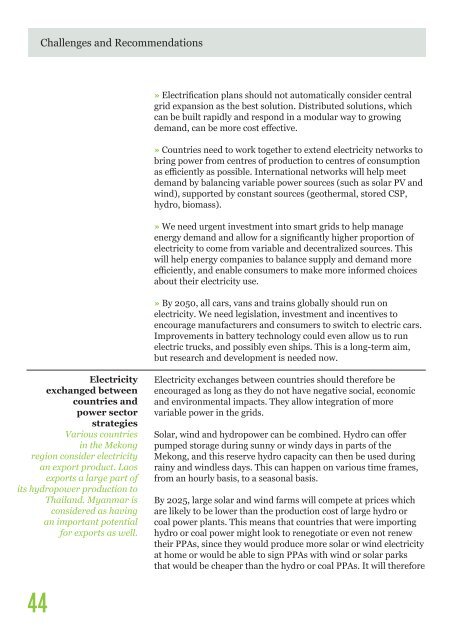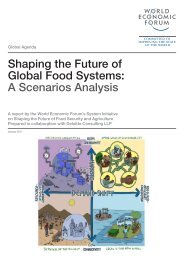Vision 2050
wwf_greater_mekong_power_sector_vision_2050
wwf_greater_mekong_power_sector_vision_2050
Create successful ePaper yourself
Turn your PDF publications into a flip-book with our unique Google optimized e-Paper software.
Challenges and Recommendations<br />
» Electrification plans should not automatically consider central<br />
grid expansion as the best solution. Distributed solutions, which<br />
can be built rapidly and respond in a modular way to growing<br />
demand, can be more cost effective.<br />
» Countries need to work together to extend electricity networks to<br />
bring power from centres of production to centres of consumption<br />
as efficiently as possible. International networks will help meet<br />
demand by balancing variable power sources (such as solar PV and<br />
wind), supported by constant sources (geothermal, stored CSP,<br />
hydro, biomass).<br />
» We need urgent investment into smart grids to help manage<br />
energy demand and allow for a significantly higher proportion of<br />
electricity to come from variable and decentralized sources. This<br />
will help energy companies to balance supply and demand more<br />
efficiently, and enable consumers to make more informed choices<br />
about their electricity use.<br />
» By <strong>2050</strong>, all cars, vans and trains globally should run on<br />
electricity. We need legislation, investment and incentives to<br />
encourage manufacturers and consumers to switch to electric cars.<br />
Improvements in battery technology could even allow us to run<br />
electric trucks, and possibly even ships. This is a long-term aim,<br />
but research and development is needed now.<br />
Electricity<br />
exchanged between<br />
countries and<br />
power sector<br />
strategies<br />
Various countries<br />
in the Mekong<br />
region consider electricity<br />
an export product. Laos<br />
exports a large part of<br />
its hydropower production to<br />
Thailand. Myanmar is<br />
considered as having<br />
an important potential<br />
for exports as well.<br />
Electricity exchanges between countries should therefore be<br />
encouraged as long as they do not have negative social, economic<br />
and environmental impacts. They allow integration of more<br />
variable power in the grids.<br />
Solar, wind and hydropower can be combined. Hydro can offer<br />
pumped storage during sunny or windy days in parts of the<br />
Mekong, and this reserve hydro capacity can then be used during<br />
rainy and windless days. This can happen on various time frames,<br />
from an hourly basis, to a seasonal basis.<br />
By 2025, large solar and wind farms will compete at prices which<br />
are likely to be lower than the production cost of large hydro or<br />
coal power plants. This means that countries that were importing<br />
hydro or coal power might look to renegotiate or even not renew<br />
their PPAs, since they would produce more solar or wind electricity<br />
at home or would be able to sign PPAs with wind or solar parks<br />
that would be cheaper than the hydro or coal PPAs. It will therefore<br />
44




